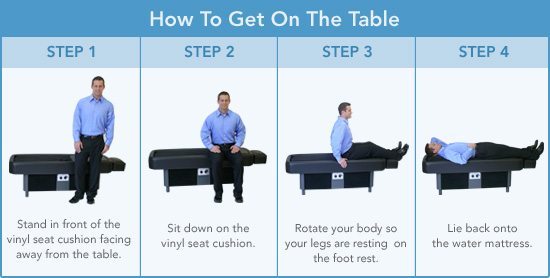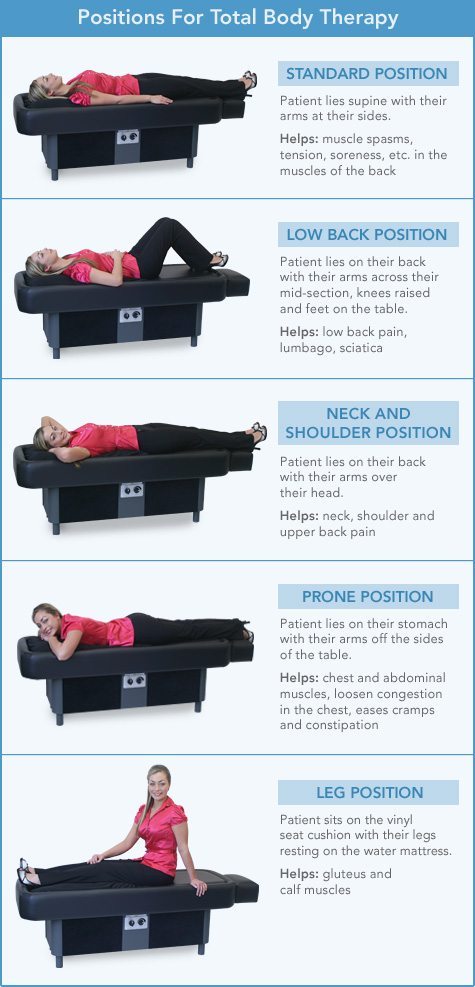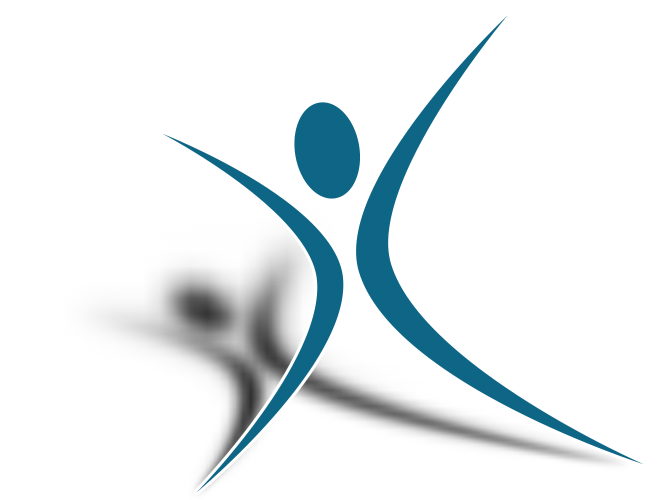How Hypdrotherapy Massage Tables Work
Hydrotherapy tables use flotation, heat, and massage to produce therapeutic effects.
By definition, hydrotherapy involves using water for the treatment of disease or trauma. In a broad sense, hydrotherapy encompasses the utilization of any of the three natural forms of water: solid, liquid, or vapor. The most common technique for hydrotherapy, in fact, employs small whirlpool tanks. These tanks allow patients to immerse one or more extremities in agitated water or to sit in the tub. Likewise, larger therapy units, such as a Hubbard tank, which incorporates larger whirlpools, can accommodate both a patient and a therapist.
DRY HYDROTHERAPY TABLES
You recline on the table, fully clothed, while a mattress filled with heated water lies just beneath the surface. A pump propels the warm water towards you through three patented hydro-jets, each spinning at nearly 200 revolutions per minute. The primary wave and a lighter, secondary wave combine to deliver a highly effective deep-tissue massage to all areas of the spine simultaneously. The therapeutic effects are a result of the combination of flotation, heat, and massage, which are described below.
Flotation:
Water exhibits exceptional buoyancy. Placing the body on the water mattress minimizes strain on the weight-bearing joints. Moreover, it necessitates very few, if any, muscles to maintain the body's position. This combination of conditions not only promotes relaxation in the patient's body but also leads to an enhanced physiological response to treatment.
Heat:
The skin evenly conducts heat into the muscles and soft tissues of the body. This heat causes blood vessels to expand, enhances blood and lymphatic circulation, increases metabolism, and induces a sedative effect.
Massage:
he water pressure on the body heightens venous and lymphatic flow, stimulating increased molecular motion in the skin, potentially aiding the healing process. Hydromassage also addresses trigger points in the muscles, which are localized areas of hyperirritability that initiate a cycle of spasm, pain, tension, weakness, and restricted joint mobility.
Hydromassage targets the muscular system, the fascia, the circulatory system, the lymphatic system, or a combination of these body systems. Fascia is the connective tissue that links organs to organs, muscles to bones (tendons), and bones to bones (ligaments). The lymphatic system carries lymph, a clear or yellowish substance that circulates throughout the body, filtering foreign matter, removing excess fluid, protein, and waste products from the tissues, and transporting them to the bloodstream for circulation and elimination.
EFFECTS OF WARM DRY HYDROTHERAPY
The major physiologic effects of hydrotherapy can be summarized as follows:
- Increases circulation and metabolic rates
- Increases mobility
- Relaxes and relieves fatigue
- Analgesia
- Sedation
- Promotes tissue healing and repair
- Relieves muscle spasms and pain
- Helps remove metabolic toxins
- Relaxes capillaries and other soft tissues
- Increases blood volume and oxygen consumption
- Relieves pain of myositis and neuritis
- Soothes irritated cutaneous nerves
- Lessens general nervousness
- Dilates blood vessels
- Soothes nerves of the visceral organs
USING THE TABLE
Most of the time, assisting people in using the tables won't be necessary, as nearly everyone can independently get on and off. However, since you might be working with individuals in pain, you may occasionally need to aid them in the process. To do so, ask the person to sit on the vinyl seat cushion, have them rotate, place their legs on the footrest, and then lie back onto the water mattress. You can support them by positioning your left hand behind their back, holding their right hand, and gently guiding them to recline onto the water mattress.

Bend down to the control panel, adjust the timer to the desired treatment duration, and select the preferred massage intensity. The table activates as soon as the timer is adjusted and automatically deactivates when the timer reaches 0.
Upon completion of the treatment, instruct the user to remain lying on the table briefly. This allows their sensory nerves to return to normal, aiding in the restoration of balance. If necessary, assist the person in getting off the table by positioning your left hand behind their back, holding their right hand, and lifting them from the mattress. They can then pivot, place their legs on the floor, and stand up.
CONTROLLING THE TEMPERATURE OF THE WATER
The temperature of the water is controlled by an electronic thermostat which is adjustable from 70° to 107° Fahrenheit. Although you can adjust the temperature of the water, you rarely will. Most users keep the temperature between 100°-107°. You just set it once and forget it. If you decide to change the setting, the thermostat is located under the seat cushion. Simply turn the dial to the desired temperature.
You set the length of treatment with the timer located on the front of the table. You can set it from 3 minutes to 30 minutes and it will automatically turn off once the time has run out. In general, the average treatment lasts 10 to 15 minutes.
The length of treatment ultimately depends on the level of spasticity and tension within the muscles, the level of pain affecting the person, how sensitive their muscles are and their personal preference. Use your professional judgement for each patient.
ADJUSTING THE MASSAGE FOR NEED AND COMFORT
The massage intensity on our Massage Time Pro model is adjustable from 12lbs. to 17lbs. of pressure. The intensity on the RejuvaWave model adjust from 2lbs. to 20lbs. You can create just the right sensation, from gentle and sooting to powerful and invigorating. You select the desired level by simply adjusting the control located on the front of the table.
The value of the therapy is the same on any setting but the option helps accommodate the needs of each person.
The massage can be used on nearly every part of the body by simply changing your position on the table. Select a suitable position based on the needs of each user.

